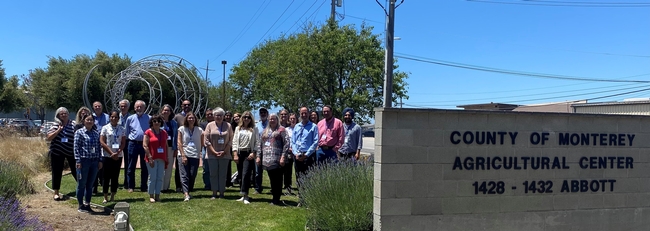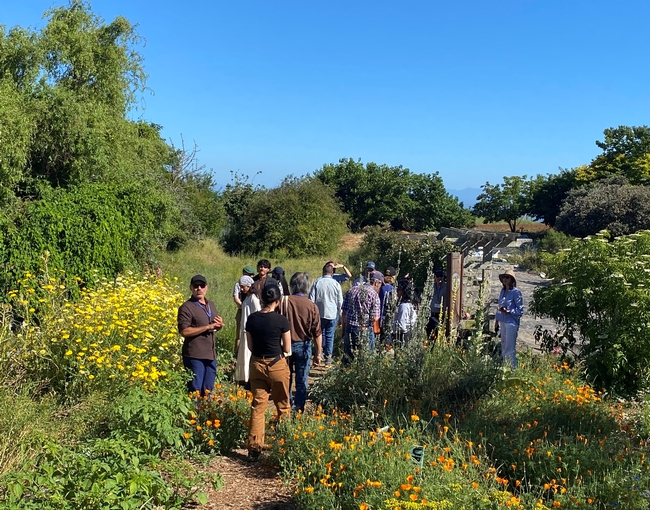Posts Tagged: June 2024
Duncan’s research ‘blew up preconceived ideas,’ improved almond, peach, grape production
Roger Duncan, UCCE farm advisor in Stanislaus County, retires after 36 years
For more than three decades, tree fruit and nut growers have depended on the advice of Roger Duncan, UC Cooperative Extension pomology farm advisor in Stanislaus County, to improve their production practices. Duncan, whose research and extension program focused on almonds, peaches, grapes and other tree crops, retired July 1.
“Roger Duncan has been an extraordinarily relevant researcher for the predominant crops in Stanislaus County,” said Rep. John Duarte, owner of Duarte Nursery in Hughson. “His research has encompassed rootstock and variety selection, tree spacing, chemical inputs and spraying, fertilizers, pruning and replanting amongst other projects.”
Duncan began working for UC ANR in 1988 as a field assistant to Integrated Pest Management advisor Jim Stapleton after earning a master's degree in plant science and plant pathology from Fresno State and a bachelor's degree in the same subjects from UC Davis. In 1990, he became a UC Cooperative Extension in pomology farm advisor in Stanislaus County.
During Duncan's tenure, the planted acreage of tree and vine crops has tripled in Stanislaus County to nearly 1,900 farms on over 230,000 acres. His research has helped to improve production efficiency through improved rootstocks, crop varieties and production practices.
“Roger provides growers with resources and tools on nutrition, sprays, nutrient deficiencies, calendars, costs, pest management and other horticultural practices,” Duarte said. “His work has had significant impact on the productivity and quality of almonds, peaches and grapes. Breeders, universities, nurseries, growers and marketers have all gained from the wisdom and dedication of Roger Duncan.”
Growing up in Modesto, Duncan wasn't raised on a farm. “I had friends whose families farmed orchard crops, so I had some exposure,” he said. “I caught the Extension bug while working as a summer intern for thepomologyadvisors in theStanislaus CountyUCCE office after I graduated with my B.S. That is what inspired me to return to school with the goal of being apomology farmadvisor.”
Reducing production costs
To help growers lower production costs, Duncan introduced orchard practices aimed at reducing hand labor and other inputs. As a result of his research, minimal pruning has become the norm in California almond production, reducing input costs and carbon output and increasing yield. He also improved monitoring and management techniques of established and invasive diseases and insect pests.
“The practical applications Roger brings to the grower community are invaluable,” said Mel Machado, Blue Diamond Almonds vice president for member relations and Stanislaus County almond grower. “His minimal pruning study stood growers on their heads. People had preconceived ideas about pruning. He blew that up. His research showed that after you get the tree's frame, all you need to remove are the dead and occluded branches. With the market depressed, we needed to cut costs. He said, ‘You don't need pruning.' Now I'm growing bushes.”
Art Bowman, a crop adviser with Salida Ag Chem, agreed that Duncan's pruning research had an impact. “Roger's pruning trial that lasted over 20 years was a much-discussed subject among growers,” Bowman said. “Growers' pruning practices definitely changed due to Roger's research, with early emphasis on structural development and, later in the tree's life, concentrating on tree accessibility and deadwood removal.”
In 1990, when Duncan joined UC Cooperative Extension, California had 408,700 acres of almonds, according to the California Agricultural Statistics Service. Now the state has over 1.5 million acres of almonds.
About 75% of the farms Duncan has served have 40 acres or less, farmed by “small” or “part-time” farmers, who needed to learn basic horticulture and pest management. Stanislaus County also is home to some very large, sophisticated growers, who Duncan has kept apprised of new technology.
“I believe that personal interaction offers the most memorable means of information transfer, which is why I held an average of 12-plus extension events per year, gave 18-plus extension presentations per year, and went on an average of over 75 individual farm calls per year,” Duncan said. He also provided information via videos, blogs, podcasts, radio shows, newsletters, news media and extension publications as well as commodity boards.
Along with Duncan's research, Bowman has appreciated his availability. “Roger was always ready to take a call, make orchard visits and listen to a grower's concern or problem,” he said.
In 1997, Duncan began hosting twice monthly Tree & Vine Integrated Pest Management breakfast meetings for pest control advisers and growers to discuss current and potential pest threats. These meetings have continued for 28 years.
He speaks ‘farmer'
Machado attributes much of Duncan's success to his communication skills. “His research is scientific and he speaks ‘farmer,'” he said.
Machado gave rootstock as an example. “Roger is my rootstock resource; he knows rootstocks better than anybody,” he said. “His rootstock trial is dirt simple. There's a different rootstock every five trees. You can see walking down the row the differences in the rootstocks.”
From his field evaluations, Duncan identified a complex hybrid rootstock that is highly tolerant to ring nematode, bacterial canker and salt toxicity. He found other hybrid rootstocks that boost crop yield while reducing risk from soil chemistry and soil-borne disease challenges, enabling almonds to be grown in the marginal soils on the west side of the North San Joaquin Valley. To help growers choose the appropriate rootstock for their soil, he wrote a comprehensive ANR publication, made a video and worked with the UC Fruit & Nut Center to create an interactive rootstock comparison website.
Over the last 15 years, use of hybrid almond rootstocks has increased dramatically. Burchell Nursery now sells approximately 40% of their trees on hybrid rootstock compared to less than 5% of almond trees 15 years ago, and more than 95% of Duarte Nursery almond trees are on hybrid rootstocks, according to Duncan.
“We've worked with Roger for years, back when he didn't have a mustache and then when he had a mustache,” said Robert Longstreth, who grows almonds, walnuts and cherries.
“Roger does research in the area you need, not frivolous stuff that you don't need,” said Longstreth, who has benefited from Duncan's research on pruning, rootstocks, irrigation timing, plant nutrition and disease control. “He's thought very highly of by almond growers. When he has something to say, people listen.”
The UCCE farm advisor has overseen long-term trials to learn how to design and maintain an almond orchard to capture early production, maintain long-term yields and maximize profits. “In the first 17 years of the orchard design project, I increased cumulative net profits by up to $14,000 per acre, including increased yield while reducing labor and carbon inputs,” Duncan said.
Influenced by Duncan's tree-spacing research results, growers have increased almond tree density by 20% per acre statewide, leading to higher crop yields, longer-living orchards and better farm economic sustainability.
As California's expert on almond rootstocks and almond orchard design, Duncan has taught the subjects for the UC Almond Production Short Course, was lead author on the UCANR publication “Almond Rootstocks,” wrote the rootstock chapter, and co-authored the orchard design chapter of the UC Almond Production Manual. He was invited to Chile, Spain and Australia to share his expertise with growers there.
Expanded programs for kids and gardeners
In addition to being a farm advisor, Duncan served as director of UC Cooperative Extension in Stanislaus County from 2011 through 2013 and again from 2017 through 2020. As the UCCE county director, he acquired new county funding to hire a 4-H youth development program representative in 2018 to provide more learning opportunities for local, underrepresented children.
That year, he also acquired county funding to hire a full-time Master Gardener coordinator and launched the first UC Master Gardener Program in the county.
“I felt very lucky to serve as an advisor in the same county where I was born and raised,” Duncan said. “I am most proud of the trust I have developed with the growers and other clientele.”
Professional awards
Recently, Duncan's peers at UC ANR honored him with a Distinguished Service Award for his outstanding extension program, which gave growers the data and confidence to adopt orchard practices that have bumped up the productivity and economic value of California almond orchards.
The popular breakfast meetings to discuss pest management earned Duncan and his UC Cooperative Extension farm advisor colleagues the Entomological Society Award of Extension Excellence and the California Department of Pesticide Regulation's IPM Innovator Award. The California Legislature also recognized the breakfast club's commitment to sustainable pest management.
“I have a lot of respect for the other farm advisors, but Roger is at the top of the pile,” said Machado, who has served on Almond Board committees with Duncan and known him since he joined UC Cooperative Extension. “I'm going to miss him. You can absolutely count on him.”
Congressman and nurseryman Duarte added: “While he will be sorely missed by us in his role of pomology advisor for the University of California, we hope that he keeps his interest, and continues to influence the food production industry in the Central Valley.”
Statewide study identifies needs and practices of farmers to adapt to climate change in California
“Climate Smart Agriculture: Assessing Needs and Perceptions of California's Farmers,” published on June 14, 2024, in Frontiers in Sustainable Food Systems, is an article based on the results of statewide survey by UC ANR scientists and their collaborators. This effort is part of the USDA-NIFA Pathways to Climate-Smart Ag project. The survey was distributed statewide and 341 farmers responded.
The findings showed that 67% of the farmers agree that climate change is happening, and 53.1% agreed that actions are required. Significantly, historically underrepresented farmers were “very concerned” about climate change-related impacts related to water resources, temperatures and natural disasters.
The study found that some farmers are currently implementing adaptation practices related to water resources management, soil health and renewable energy and are also seeking insurance and government assistance programs to enhance their resilience to climate change. Farmers also expressed “interest” and “high need” for more information on those adaptation practices to manage various challenges of farming in the current and future variable climates.
The study identified that more than half of the farmers believe the most “significant barriers” to adaptation are mainly government regulations (53.1%), followed by high input cost (46.9%), labor access/cost (35.2%), access to water (33.5%), and access to investment capital/funds (32.4%).
The needs assessment also established that farmers use climate decision-support tools (47.5%), mostly weather stations; and 51.9% indicated their interest in using online tools designed to translate climate information into forms that support production decision-making. On extension education and information access, farmers responded that they will likely attend workshops to learn about adaptation practices (60.8%).
The findings of this needs assessment are being used to develop and deliver climate smart agriculture programs for farmers and ranchers in California.
The project is led by Tapan Pathak, UC Cooperative Extension specialist in climate adaptation in agriculture based at UC Merced, as the project director. Steven Ostoja, director of the U.S. Department of Agriculture California Climate Hub, and Vikram Koundinya, UCCE evaluation specialist, serve as co-PDs, with support from Leslie Roche, UCCE rangeland management specialist; Daniele Zaccaria, UC Davis associate professor and UCCE agricultural water management specialist; and Mark Cooper, UC Davis assistant professor in community and regional development.
The article was written by a team with diverse expertise in climate and agricultural sciences, social sciences, and extension academics and evaluation experts. Authors include Samuel Ikendi, Natalia Pinzon, Koundinya, Namah Taku-Forchu, Roche, Ostoja, Lauren Parker, Zaccaria, Cooper, Jairo Diaz-Ramirez, Sonja Brodt, Mark Battany, Jhalendra Rijal and Pathak.
Reference
Ikendi, S., Pinzon, N., Koundinya, V., Taku-Forchu, N, Roche, L., Ostoja, S., Parker, L., Zaccaria, D., Cooper, M., Diaz-Ramirez, J., Brodt, S., Battany, M., Rijal, J., & Pathak, T. (2024). Climate smart agriculture: Assessing needs and perceptions of California's farmers. Frontiers in Sustainable Food Systems, 8, 1395547. https://doi.org/10.3389/fsufs.2024.1395547
Why become a certified California Naturalist?
I recently came across a national forum thread on iNaturalist where someone was curious to know more about the value of becoming a “certified” naturalist. Not surprisingly there were a wide range of opinions. These ranged from supportive to skeptical to cynical. Because many of the responses came from people who have not taken a course themselves, I thought it might be valuable to share some data from people who actually completed a course – in this case the UC California Naturalist course offered by over 60 different organizations around the state, in partnership with UC ANR's Environmental Stewards program.
To summarize the forum discussion, the believers – commonly people who actually have taken a course – found that taking a course was useful for people who were new to an area, had no previous science background, or were looking for ways to connect and engage in volunteer service locally. The skeptics often cited the improbability of becoming a “master” or expert in anything after just taking a short course or the fact that a degree in many science fields would render certification unnecessary. Finally, the more cynical views suggested that certification was just another ploy to separate people from their money.
In California, our end-of-course evaluation provides some useful insight on the reasons why people pursue naturalist certification, as well as their level of satisfaction with the course. The five most commonly cited reasons for pursuing naturalist certification from over 1,000 respondents were 1) to learn more about the local environment, 2) learn about conservation issues, 3) spend time outside, 4) career development, and 5) meet people with similar interests. Securing the certification itself ranks sixth out of 10 choices and rarely is the driving factor for taking the course.
Regardless of their rationale for taking the course, 72% of those who completed the course were very satisfied with their experience and 93% were either very or somewhat satisfied. In terms of putting their experience to use, 95% of the respondents indicated that participation in the course improved their capacity to do their volunteer service and the majority indicated they plan to do more volunteer service in the coming year.
Increasing numbers of participants are looking at the course as a form of professional development and about 93% indicated that participation in the course improved their capacity to do their work or the work they would like to do in the future. Anecdotally, we find the social learning component of our program and our efforts to create an inclusive community of naturalists to be essential to the high levels of satisfaction and an important factor in sustained engagement.
It's also important to address the skeptical views and challenge the more cynical views of certification. First, no reputable naturalist certification program claims to make expert naturalists in a matter of a dozen weeks. The use of the term “master” naturalist is problematic for that and other reasons, which is why it's not used in our program in California. We all agree that expertise is gained over time – often a lifetime – and our program is happy to simply inspire, support or reinforce that pursuit.
Finally, while we live in a time full of scams, cons and frauds, the suggestion that certification is just a way to separate you from your money really reinforces my view of the debilitating nature of cynicism. Most naturalist certification programs are run on a shoestring budget. Statewide program costs are often supported by land-grant universities, nonprofits or state agencies. The registration fees of a typical course are barely enough to cover the costs of the educators who deliver them. State and local programs regularly pursue grants, constantly writing proposals to ensure that cost isn't barrier to participation. Having worked in this field for several decades now, I can safely say that the course instructors are driven not by profits but by their values and deep sense of purpose.
So, when someone asks you about California Naturalists or Climate Stewards, let them know what certification really means. Embrace their interest, address their skepticism, redirect their cynicism and invite them to join our community and transform the way they see their environment and their role in protecting it.
Program Council visits UC ANR sites in Monterey Bay area
Every year the UC ANR Program Council visits programs for one of their monthly meetings. In June, they toured several sites in the Monterey Bay area.
Their first stop was UC Santa Cruz, where they met with Katharyne Mitchell, sociology professor, Agricultural Experiment Station faculty member and dean of the Division of Social Sciences. Joji Muramoto, UC Cooperative Extension organic production systems specialist, and three of the five new AES faculty located at UCSC – Matt Sparke, professor of politics; Greg Gilbert, professor of environmental studies; and Michael Loik, professor of environmental studies – described their research. The group walked around the UCSC Farm, learning about its 53-year history advancing small-scale, organic production and hearing from students what the experience has meant to them.
Next they headed to Marina to discuss the innovation initiatives at the UCSC Monterey Bay Education, Science and Technology Center (MBEST) and the developing collaboration with UC ANR focused on ag tech research and homebase for the new UC Cooperative Extension specialist position to work on food safety, drones and remote sensing.
They had lunch with staff at the UCCE Monterey County office in Salinas, then local farm advisors gave presentations on their research and extension. Michael Cahn discussed CropManage. Aparna Gazula and Mark Bolda described their work with non-English speaking farmers. Devii Rao talked about cattle grazing as a tool for wildfire prevention.
Their last stop was at the USDA Agricultural Research Service Lab for Crop Improvement and Protection Research in Salinas, where the recently announced UCCE specialist in coastal produce safety systems will be located, growing the cohort of UCCE specialists there.
L&D: Community engagement, WIC at 50, health equity, program development, access, disability awareness
UC ANR Learning & Development
Landing page | Archived webinars | Learning resources
Extension Methods & Delivery
Building Support
Equity, Diversity, Inclusion
Office, Team, & Personal Management
Community Engagement: Intro to Motivational Interviewing (Virtual, Extension Foundation)
July 11, 2024 | 11 a.m. - Noon PDT
Register here.
Join us for an engaging workshop on Motivational Interviewing (MI), tailored for Cooperative Extension professionals. During this workshop, you will learn how to use Motivational Interviewing to engage community members in conversations about health behavior change and facilitate impactful conversations in group settings, even within your teams.
WIC at 50 Years: Honoring the Past, Nourishing the Future (Virtual, Extension Foundation)
July 16, 2024 | 8 - 9:30 a.m PDT
Register here.
By the end of this webinar, attendees will:
- Discover the history of WIC including key programmatic milestones, and the impact of WIC on maternal and child health over the past 50 years.
- Describe the WIC food packages, how they have evolved, and the most recent changes.
- Identify innovations in WIC that support the future of WIC as the premiere public health program.
Effective Communication and Outreach - Health Equity Communication (Virtual, Extension Foundation)
July 25, 2024 | 11 a.m. - Noon PDT
Register here.
Learn about communicating to promote health equity and resources/frameworks to use.
Program Development & Evaluation Capacity Building Training Series, 2024 (Virtual, UC ANR)
Aug. 6-Oct. 15, 2024| Every Tuesday, 10 a.m. - Noon
Register here.
Join us for online interactive trainings to help you with planning and evaluating programs and projects. These trainings highlight UCCE examples. This 11-part series is offered a la carte. Select whichever interests you or take the complete series! Audience: CE academics, community educators and other program staff. New advisors and county directors are highly encouraged to attend.
Aug. 6: Defining Clientele & Affirmative Action Planning
Aug. 13: Improving All Reasonable Effort & Engagement with Diverse Audiences
Aug. 20: Conducting a Needs Assessment
Aug. 27: Using Delphi Method for Needs Assessment
Sept. 3: Practical Methods to Measuring Outcomes
Sept. 10: Using Ripple Effects Mapping Method in Program Evaluation
Sept. 17: Best Practices for Developing Surveys & Basics of Sampling Methods
Sept. 24: Navigating Institutional Review Board
Oct. 1: Methods to Analyze Surveys: Continuous Quantitative Data
Oct. 8: Methods to Analyze Surveys: Qualitative Data
Oct. 15: Writing Strong Impact Statements
The UC ANR Office of Contracts and Grants (UC ANR) is the authorized organizational representative for all extramurally sponsored projects at UC Agriculture and Natural Resources. Find the analyst assigned to your county or program.
Government Relations (UC ANR)
Engaging government officials and community stakeholders is a critical tool that helps builds awareness and support for your work and that of the University as a whole. For more information, read here.
Public & Media Relations (UC ANR)
UC ANR has subject matter experts to help you with media and other public relations. Be sure to contact them for support.
Access & Belonging - Virtual Summer School (Extension Foundation)
July 8 - 12 | Noon - 1 p.m.
Disability Awareness in the Workplace
July 16 | 1:30 – 2:30 p.m.
Join Ian Smith and Jodi Rosenbaum to become more aware about how to support employees with disabilities in the workplace, the Reasonable Accommodation Process, and the Americans with Disabilities Act.
Join Zoom Meeting
https://ucanr.zoom.us/j/93898213427?from=addon
Meeting ID: 938 9821 3427
UC Managing Implicit Bias Series: What is Implicit Bias? (Virtual, UC Learning Center)
Start here.
In this course, we'll define implicit bias and exploring how it derives from the natural way human brains function. After completing this course, you should be able to:
- Describe how the brain uses shortcuts and schemas to process stimuli
- Explain how attitudes, stereotypes and biases form
- Differentiate between explicit and implicit biases
Clean Your Website and Make it More Accessible, Office Hours (UC ANR IT, Training & Development Specialist, Stephen Dampier)
Every Tuesday and Thursday | 3 - 4 p.m.
Join Stephen during his weekly office hours to learn what can be cleaned up from your webpages before integration with the new Integrated Web Platform (IWP). Let Stephen test your pages for accessibility and learn how to make it more accessible.
Zoom meeting: https://ucanr.zoom.us/j/97937501529?pwd=Zm1PaGRuc0htcnVZbmZQaGcya3oxQT09
How to Align Your Time with Your Priorities (Virtual, NCFDD)
Watch recording.
In case you missed this event...Grab your strategic plan and learn the secret to making it work day-to-day and week-to-week! How to Align Your Time with Your Priorities is a step-by-step guide to holding a weekly planning meeting (aka The Weekly Meeting). UC ANR pays for your access. Register here for your account.
In this webinar, you'll learn:
- What works…and what DOESN'T work when it comes to weekly planning
- Why weekly planning is the bridge between your strategic plan and getting control of your workday
- The 30-minute technique that will help you make sure that the most important things get done each day
Master Digital Marketing Series Certificate (LinkedIn Learning)
Link to learning path.
Enhance your digital marketing expertise by diving deeper into best practices for your strategies--from social media to SEO and beyond. For your LinkedIn Learning account, contact ANR IT at help@ucanr.edu.
Learn something new today.
Image credits:
Gordon Johnson from Pixabay
Copyright 2017 - Robert Wood Johnson Foundation
Clker-Free-Vector-Images from Pixabay
















